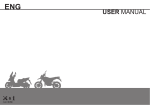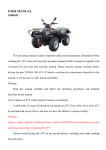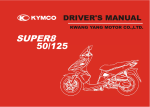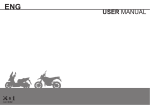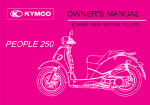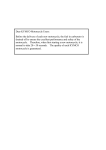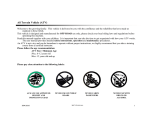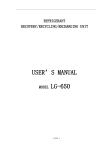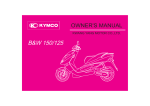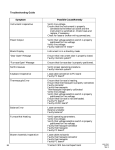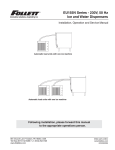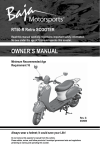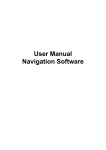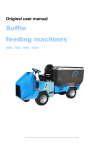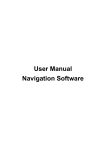Download OWNER`S MANUAL Vitality 50
Transcript
KWANG YANG MOTOR CO., LTD. OWNER’S MANUAL Vitality 50 2 STROKE & 4 STROKE Dear KYMCO Scooter Users: Thank you for purchasing this KYMCO scooter and welcome to the family of KYMCO scooter riders. To enjoy safer and more pleasant riding, become thoroughly familiar with this owner's manual before you ride the scooter. Your safety depends not only on your own alertness and familiarity with the scooter but also the scooter’s mechanical condition. A pre-ride inspection before every outing and regular maintenance are essential. The quality of each KYMCO scooter is guaranteed. NOTE: 1. The information and specifications stated in this manual are for reference only and subject to change without notice. 2. When starting the engine, the battery must be installed to facilitate starting and increase the engine performance. TABLE OF CONTENTS 1. ENSURING A SAFE RIDE 2. PARTS LOCATION VIN NUMBER ENGINE NUMBER KEY NUMBER 3. OPERATING INSTRUCTIONS IGNITION SWITCH HANDLEBAR LOCK ELECTRIC STARTER BUTTON HEADLIGHT SWITCH HEADLIGHT DIMMER SWITCH PASSING SIGNAL SWITCH HORN BUTTON TURN SIGNAL SWITCH SEAT LOCK MET-IN BOX (UNDERSEAT STORAGE) HELMET HOLDER CENTRE HOOK INSTRUMENTS & INDICATORS 4. PRE-RIDE INSPECTION ADVANCE INSPECTION ENGINE OIL LEVEL / REFILLING TIRE INSPECTION 1 3 7 8 9 10 10 10 11 11 12 12 13 13 14 14 14 15 16 18 18 18 21 TABLE OF CONTENTS TABLE OF CONTENTS 5. 6. 7. 8. 9. FUEL LEVEL INSPECTION / REFILLING STEERING HANDLEBAR INSTRUMENT LIGHTS INSPECTION BRAKE FLUID LEVEL INSPECTION BRAKE PAD WEAR BRAKE SHOE WEAR BRAKE LEVER FREE PLAY INSPECTION & ADJUSTMENT HORN / LIGHT INSPECTION FRONT / REAR SHOCK ABSORBER INSPECTION BRAKE PERFORMANCE INSPECTION BACK MIRROR ANGLE CHECK LICENSE PLATE CHECK REFLECTOR CHECK PREVIOUS ABNORMAL PARTS INSPECTION LUBRICATION POINT CHECK ENGINE STARTING METHODS NORMAL RIDING METHOD PRECAUTIONS FOR RIDING HOW TO STOP RIDING EASY MAINTENANCE AIR FILTER CLEANING & REPLACEMENT CLEANING EXTERIOR SURFACES BATTERY 23 24 24 25 26 26 27 29 30 30 30 30 30 30 30 31 34 36 39 41 41 45 46 TABLE OF CONTENTS TABLE OF CONTENTS FUSE REPLACEMENT ENGINE OIL CHANGE (4 STROKE) TRANSMISSION GEAR OIL SPARK PLUG INSPECTION BRAKE FLUID LEVEL INSPECTION / REFILLING RUBBER COVER INSPECTION FOR WIRE & CABLE 10. IMPORTANT NOTICES POLLUTION-FREE MAINTENANCE SCHEDULE SPECIFICATIONS 11. KYMCO CLEAN AIR SYSTEM (FOR EURO 2) 48 50 51 55 56 56 57 58 59 61 1. ENSURING A SAFE RIDE RIDING GEAR • In order to ensure a safe ride be sure to relax and wear comfortable clothing. • Observe all traffic laws and be careful. o Always wear a helmet and make sure it is fastened. o Arrange your clothing – fasten shirt cuffs to prevent them from hooking the brake lever. o Wear low healed shoes. o When riding, use both hands to grasp the handlebar. It is very dangerous to hold the handlebar with just one hand. • A scooter rider should NEVER wear loose clothing • To avoid the risk of being burned, DO NOT touch the exhaust muffler during or up to 10 minutes after riding. • When parking the scooter, keep it away from dry grass or any other flammable objects or materials. -1- RIDING METHOD • Safety on a two-wheeled vehicle is influence by seating position. The rider should sit on the central part of the seat cushion. Should the rider sit on the rear part of the seat, the load of the front wheel will decrease, the handlebars could swing therefore putting the rider in danger. • When making a turn, it will be easier for the rider to steer the scooter by leaning the body inward slightly. Failure to do this could result in a loss of balance. • When riding on a damaged or gravel road be sure to slow down your speed and hold the handlebars tightly. CARRYING GOODS • Maintain proper posture at all times while operating the scooter. • The handlebars will feel different when carrying goods on the scooter. Overloading may cause the handlebars to swing. Do not exceed maximum loading capacity. i. Maximum loading capacity of the met-in box is 10 kg. ii. Maximum loading capacity of the rear carrier is 5 kg. -2- 2. PARTS LOCATION 1) Headlights switch – pg 11 electric started button – pg 11 2) Right turn signal indicator light – pg 17 3) Speedometer – pg 16 4) Left turn signal indicator light – pg 17 5) Headlight dimmer switch – pg 12 Passing signal switch – pg 12 Turn signal switch – pg 13 Horn button – pg 13 -3- 1) 2) 3) 4) 5) 6) 7) 8) 9) Seat lock – pg 14 Fuel fill cap – pg 23 Met-in box – pg 14 Helmet holder – pg 14 Centre hook – pg 15 Side stand Centre stand Kickstarter pedal – pg 34 Air cleaner housing – pg 43 -4- 1) Ignition switch – pg 10 2) 2-stroke : Engine oil tank cap – pg 18 -5- 1) 2-stroke: low oil level indicator – pg 17 4 stroke: low beam indicator – pg 17 2) rear brake lever – pg 27 3) battery – pg 48 fuse – pg 50 4) throttle grip 5) front brake lever 6) high beam indicator light – pg 17 -6- VIN NUMBER To read the VIN number, remove the cover from knee shield with a flat head screwdriver. Always check that the VIN stamped on your scooter is the same as the VIN written in any documentation as well as your warranty card. Please write your VIN for easy reference in the space provided below. VIN: __________________________________ -7- ENGINE NUMBER The engine number is stamped on the right engine case. Please write down your engine number for easy reference in the space provided below. ENGINE NUMBER: ____________________________ -8- KEY NUMBER The key number (1) will be required if you need to order a replacement key. Please write down your key number for easy reference in the space provided below. ___________________________________ -9- 3. OPERATING INSTRUCTIONS IGNITION SWITCH / HANDLEBAR LOCK (1) ON: In this position power is connected and you are able to start the engine. The key cannot be taken out (2) OFF: In this position, there is no power connected and the engine will stop. The key can be taken out. (3) LOCK: In this position the handlebar is lock. The key can be taken out. Locking Method The handlebar can be locked by turning the handlebar to the left as far as possible. Push and turn the ignition switch key counter clockwise until you reach the “LOCK” position. Unlocking Method Turn the ignition switch key clockwise until you reach the “OFF” position. The “LOCK” will release automatically. - 10 - ELECTRIC STARTER BUTTON To start the engine the ignition switch must be turned to “ON”. Fully apply the front or rear brake lever to connect the power and then push the electric starter button. • To avoid engine damage do not push the electric start button while the engine is running. • Before using the electric start button be sure that The headlight and turn signal switches are in the “OFF” position. • Release the electric start button immediately after the engine has started. HEADLIGHT SWITCH In this position the parking light, headlights, instrument lights and taillight turn off together. In this position the parking light, instrument lights and taillight are turned on. In this position the parking light, headlight, instrument lights and taillight are turned on. - 11 - HEADLIGHT DIMMER SWITCH / PASSING SIGNAL SWITCH (1) Switch to this position for using high beams. (2) Use low beams when driving in a downtown area or when there is oncoming traffic. High beams can affect the visibility of oncoming traffic. An indicator light appears when you turn your high beams on! PASSING This switch allows you to flash your high beams if necessary to other vehicles. - 12 - HORN BUTTON / TURN SIGNAL SWITCH • When the ignition switch key is in the “ON” position, push the horn button and it will sound. • Move the turn signal switch to (1) → this will activate the right turn signal • Move the turn signal switch to (2) ← this will activate the left turn signal • Push the button (3) to release the turn signal switch. • Press (4) to use the horn. The turn signal light will NOT release automatically. Be sure to manually release the turn signal switch. Failure to do so may affect traffic safety. - 13 - SEAT LOCK / MET-IN BOX (UNDERSEAT STORAGE) • Unlock the seat – you can store your helmet in the met-in box (under seat storage) • To unlock: Stop the engine and turn the ignition switch key to the “OFF” position. Insert the ignition switch key into the seat lock and turn it clockwise. • To lock the seat, push down on it and it will lock automatically. Make sure the seat is secure before riding Never put the key inside the seat cushion to lock the seat. HELMET HOLDER 1. Open the seat using the ignition switch key (see above) and lift seat. 2. Put the helmet retaining ring into the helmet holder 3. Put the seat down and it will lock automatically To take the helmet out, reverse the order of the above instructions. When riding be sure you are wearing the helmet and that it is not still on the scooter. The helmet may interfere with the safe operation and could result in a loss of control. - 14 - CENTRE HOOK 1. To use, pull the hook out from the inside (1) 2. Push the lock lever to the left (2) to unlock and hang your bag on the hook 3. To remove the bag unlock the lock lever and lift the bag off the hook. 4. When you’re not using it, push the hook back into its original position to avoid hooking your clothes while you are riding. - 15 - INSTRUMENTS & INDICATORS (1) FUEL GAUGE: The fuel gauge shows the volume of gasoline in the fuel tank. If the fuel gauge pointer is at the “E” area, fuel levels are low or empty. Refill with unleaded gasoline (either 92 or 95) as soon as possible. (2) SPEEDOMETER (km/hr): The riding speed is indicated in kilometers per hour. (3) SPEEDOMETER (mph): The riding speed is indicated in miles per hour. (4) ODOMETER: The total riding distance is indicated in kilometers. The figure in black and white is in units of 100 meters. (5) CLOCK METER: Displays time and date which can be adjusted manually. (6) ADJUST KEY: Used to alter time and date. - 16 - (7) TURN SIGNAL INDICATOR LIGHT (LEFT): This indicator light will blink if you are using the left turn signal. (8) LOW OIL LEVEL INDICATOR: When the ignition switch is in the “ON” position, it is normal that the low oil level indicator lights up for several seconds. If the light does not turn off, it means that the engine oil level may be low. (9) HIGH BEAM INDICATOR LIGHT: Lights up when you are using your high beams. (10) TURN SIGNAL INDICATOR LIGHT (RIGHT): This indicator light will blink if you are using the right turn signal. (11) LOW BEAM INDICATOR LIGHT: Lights up when you are using your low beams. - 17 - 4. PRE-RIDE INSPECTION ADVANCE INSPECTION • Get into the good habit of inspecting your bike before riding. • A pre-ride inspection is an absolute requirement in order to minimize risks while riding, and prevent vehicle damage and traffic accidennts. Maintenance and inspection of your new scooter should be performed after it is ridden for 300km. ENGINE OIL LEVEL INSPECTION / REFILLING 2-STROKE • When the low oil level indicator lights, it means the oil level in the tank is low. Stop the engine and fill the oil tank as soon as possible. To fill: lift the seat (pg 14), remove the cap (1) from the oil tank. - 18 - • Fill with the recommended oil up to the upper level mark (2). OIL RECOMMENDATION: Use KYMCO 2-stroke oil or its equivalent • If the low oil level indicator comes on while riding, stop riding and shut off the engine. Fill the oil tank to the upper level mark with the recommended oil. Riding with a low oil level may lead to engine failure which could result in an accident. • If the engine was running at any time while the low oil level indicator light was on the scooter must be taken to an authorized KYMCO dealer immediately for inspection and bleeding of the oil system. Failure to do this will result in serious engine damage • The use of improper oils may cause excessive and/or premature carbon build-up in the engine and exhaust system, resulting in a loss of power and possible engine damage. • When filling, do not let dirt or other foreign materials enter the tank. - 19 - 4-STROKE • Place the scooter on its main stand. Take out the oil dipstick and wipe it clean. • Directly insert the oil dipstick into the engine oil. (Do not screw it in) • Take out the oil dipstick and check the oil level. If it is close to the lower limit, add engine out to the upper limit. • Be careful when checking the oil level. The temperature of the engine and exhaust muffler is very high. • Riding with an insufficient amount of engine oil could cause engine damage resulting in a breakdown. - 20 - TIRE INSPECTION 1. TIRE PRESSURE CHECK • Check if the tire pressure is normal when the tire is in contact with level ground. • If the tire looks over or under inflated, check the pressure with a tire pressure gauge. • Measure the tire pressure at room temperature. • The tire pressure must not surpass 2.50kg/cm2 NORMAL PRESSURE ( 1 RIDER / 2 RIDERS) Front Wheel 1.5/2.0 kgf/cm2 Rear Wheel 1.75/2.25 kgf/cm2 - 21 - 2. Cracks and other damage • Check the tire contact area for any cracks or other damage. 3. Abnormal Wear • Check the tire contact area for any abnormal wear and tear. 4. Foreign objects, metal pieces, and gravel • Check the tires and tire contact area for imbedded objects including pieces of metal and graval. 5. Depth of tire groove • If the tire is worn to the wear limit indication mark replace it with a new one. • Incorrect tire pressure, cracks, damage and abnormal wear may cause the tire to blow out or deflate. • If the tire has any crack or is worn to the wear limit indication mark replace it with a new one. - 22 - FUEL LEVEL INSPECTION / REFILLING • Check if the fuel levels are sufficient. • If the fuel gauge pointer is at “E” grid, refill with unleaded gasoline (either 92 or 95) Refilling Method 1. Lift the seat (pg 13), then remove the fuel fill cap (1) by turning it counter clockwise. 2. After refuelling, be sure to tighten the fuel fill cap firmly by turning it clockwise. Make sure that the markings (2) on the fuel fill cap and tank allign. • Use unleaded fuel only. It produces fewer engine and spark plug deposits and extends the life of the exhaust system. • Do not overfill the tank - there should not be fuel in the filler neck (3) after refuelling. Make sure the fuel fill cap is securely closed. - 23 - STEERING HANDLEBAR • Visually inspect the steering handlebar for damage. • Apply the front brake and move the handlebar up and down to check for any abnormal noise. • Move the steering handlebar up, down, left, and right to check for any loose parts. • Check to make sure that the handlebar rotates freely. • If any abnormal condition is found, take your scooter to your authorized KYMCO dealer for inspection. INSTRUMENT LIGHTS INSPECTION • Check the turn signal indicator lights and high beam indicator light to ensure that they are operational. • Check the speedometer to ensure that it is operational. • Check the fuel gauge to ensure that it is operational. • Check the low oil level indicator light to ensure that it is operational. - 24 - BRAKE FLUID LEVEL INSPECTION • Check through the inspection window to see if the fluid level is below the lower level mark. • As the brake pads wear, brake fluid levels drop, automatically compensating for the wear. There are no adjustements to perform, but fluid level and pad wear must be inspected regularly. To ensure that there are no fluid leaks, inspect frequently. • If the brake lever travel becomes excessive and the brake pads are not warn beyond the recommended limit, there may be air in the brake system and it must be bled. See your authorized KYMCO dealer for this service. • To prevent damage to the brake system, use only fluid from a sealed container. Never allow contaminents (dirt, water, etc.) to enter the brake fluid reservoir. • Brake fluid can damage paint and plastic, therefore, handle the fluid with care. When adding brake fluid, be sure the reservoir is horizontal before removing the cover to prevent accidental spillage. • Use only DOT 4 brake fluid from a sealed contariner. - 25 - BRAKE PAD WEAR • Check the wear indicator mark on each pad. If either pad is worn to the wear indicator mark, replace both pads as a set. See your authorized KYMCO dealer for this service. BRAKE SHOE WEAR • The rear brake is equipped with a brake wear indicator. When the brake is applied, an arrow mark (1) attached to the brake arm moves towards a reference mark (2) on the brake panel. If the arrow mark aligns with the reference mark on full application of the brake, the brake shoes must be replaced. See your authorized KYMCO dealer for this service. - 26 - BRAKE LEVER FREE PLAY INSPECTION & ADJUSTMENT • The rear brake lever free play should be adjusted to 10-20mm (0.4-0.8in) at the tip of the brake lever. If the free play is incorrect, follow these instructions to adjust: Turn the adjusting nut in direction (A) to decrease play, and in direction (B) to increase play. Turn the adjusting nut on the brake hub in direction (A) to decrease Play, and in direction (B) to increase play - 27 - Make sure the cut out on the adjusting nut (2) is seated on the brake arm pin (1) after making final free play adjustment. - 28 - HORN / LIGHTS INSPECTION • Turn the ignition switch to the “ON” position and push the horn button to check if it sounds • Headlight / Taillight inspection: Start the engine and turn on the headlight switch to check if the headlight and taillight are working properly. Also check the light shells for any dirt and damage. • Brake light inspection: Apply the front and rear brake levers respectively to check if the stoplight is working properly. Also check the light shell for dirt and damage. • Turn Signal Light inspection: Operate the turn signal switch to ensure that the right/left front and rear turn signal lights flash. Also check the light shells for dirt and damange (1) Headlight (2) Taillight / Stoplight (3) Turn Signal Light (4) Horn Replace any dirt or damaged lights with new ones to avoid danger and ensure a safe ride! - 29 - FRONT/REAR SHOCK ABSORBER INSPECTION • Check the condition of the front and rear shock absorbers by pressing down on the handlebar and seat several times. BRAKE PERFORMANCE INSPECTION • Fully apply the front and rear brake levers and move the scooter forward to see if the braking effect is good. BACK MIRROR ANGLE CHECK • Sit up straight on the scooter and check the angle of your mirrors. LICENSE PLATE CHECK • Check the license plate for dirt and damage, then tighten it. REFLECTOR CHECK • Check the reflector for dirt and damanges. PREVIOUS DAMAGE INSPECTION • Verify that any previous damage has been serviced and repaired. LUBRICATION POINT CHECK • Visually varify that all motorcycle lubrication points are properly lubricated. - 30 - 5. ENGINE STARTING METHODS TURN THE IGNITION SWITCH “ON” • Unlock the steering handlebar • Turn the ignition switch to the “ON” position • Check the gasoline volume and engine oil level before starting the engine. • Be sure that both the centre and side stands are up before starting the engine. LOCK THE REAR WHEEL • Apply the brake lever to connect the power for starting. • In order to prevent the scooter from rushing out from underneath you at high speed, make sure to lock the rear wheel. • If there is excessive brake lever free play, the bike may experience loss of braking power. - 31 - USING THE ELECTRIC STARTER BUTTON • Push the electric starter button without rotating the throttle grip. • If the engine fails to start after the electric starter button is Pressed for 3 – 4 seconds when it is warm, rotate the throttle grip for 1/8 – 1/4 turn to facilitate starting. • It may be difficult to start the scooter if it has not been used for a long period of time or if the fuel tank is empty. If the engine is still hard to start after the fuel tank is refilled with gasoline, slightly turn the throttle grip and push the electric starter button simultaneously several times to start the engine. • In order to avoid battery overcharge, do not push the starter button for more than 5 seconds. • If the engine does not start after the electric starter button has been pushed for more than 5 seconds, wait an addition 5 seconds before pushing the button again. • Pushing the electric starter button while the engine is running could seriously damage the engine. • When starting the engine remember to that the rear brake lever must be applied to connect power. The brake light will come on when power has been connected. - 32 - STARTING WITH THE KICK PEDAL 1. Place the scooter on its main stand on level ground. 2. Depress the kick pedal with force. • When the engine is cold and does not start after the kick pedal is depressed 3 – 4 times, rotate the throttle grip for 1/8 – 1/4 turn to facilitate starting. • Warm up the engine for approximately 2 – 3 minutes after a cold start. • By avoiding sudden accelerations and by riding at low riding speeds after starting the engine the engine service life will be prolonged. • After starting the engine be sure that the kick pedal is returned to its original position. • The exhaust contains carbon monoxide which is poisonous and is harmful to the human body. Never run the engine in a closed area. • Turn off all light switches before starting the scooter. - 33 - 6. NORMAL RIDING METHOD STARTING THE ENGINE • Start the engine by referring to the starting methods specified in section 5. • Remember that pushing the electric starter button while the engine is running could seriously damage the engine. • The rear brake lever should be held down in the braking position before riding. REBOUNDING THE MAIN (CENTER) STAND • Keep the rear brake lever in a braking position and push the scooter forward. The main (center) stand will rebound automatically. • After starting the engine but before moving, do not turn the throttle grip to increase engine RPM! - 34 - CORRECT SITTING POSITION • Ride astride on the scooter from the left side and sit upright. Touch the ground with your left foot to avoid slipping. • The rider must wear helmet, gloves, have proper eye protection and avoid wearing any clothing that could affect rider safety. ROTATE THE THROTTLE GRIP • Release the rear brake lever and slowly rotate the throttle grip, then the scooter will move smoothly. • To prevent the scooter from rushing out from under you, do not rotate the throttle grip suddenly after the rear wheel brake lever is released. • To save on fuel and prolong the life of your scooter, avoid rapid or sudden acceleration and deceleration. - 35 - 7. PRECAUTIONS FOR RIDING CORRECT RIDING • Before riding anywhere, use your signal lights to indicate your Where you are going and be sure to conduct a shoulder check.. • Do not rush into the car lanes, and be sure to follow all provincial rules for motorcyclists. • Moderate riding will prolong the engine service life. The clutch linings are worn more quickly if the scooter is ridden regularly at low speeds. SPEED CONTROL • The speed is controlled by the throttle grip. (1) ROTATE: • The speed will increase. • When riding on an ascending road, rotate the throttle grip gradually to increase the horse power. (2) RESTORE: • The speed will decrease. Restore the throttle grip quickly. • To shorten the time required to slow down, apply the brake lever while restoring the throttle grip. - 36 - PROPER RIDING WILL PROLONG ENGINE LIFE • For a new scooter, keep the speed below 40km/h for the first 1000km of riding. • Avoid sudden acceleration and riding at high speeds for a long period of time. • If the engine is left idling for a long period of time in hot weather it could overheat. If this happens, stop the engine immediately. • Remember: moderate riding will prolong the engine life! APPLY BOTH FRONT & REAR BRAKE LEVERS WHEN BRAKING • First restore the throttle grip to the closed position and then tightly squeeze the brake levers. • The best way to brake the scooter is to start by lightly squeeze the brake levers at the beginning and then increase to a tight squeeze. • Applying a single brake lever will cause the scooter to skid resulting in possible loss of control and injury to rider. • Making a sudden stop may cause the scooter to skid resulting in possible loss of control and injury to rider. - 37 - DO NOT MAKE SUDDEN STOPS OR SHARP TURNS • Sudden stops and sharp turns are the main causes for skidding and loss of control which could be very dangerous to the rider. • Use extra caution when riding the scooter in the rain – this will increase the probability of skidding and loss of control. • When approaching a corner or turn, close the throttle fully and be sure to slow down the scooter using both the front and rear brakes simultaneously. After completing the turn, open the throttle gradually to accelerate the scooter. USE EXTRA CAUTION WHEN RIDING IN THE RAIN • A longer braking distance is required on rainy days when the roads are wet. Adjust your speed for the weather conditions and remember to brake the scooter slowly and as early as possible. • When riding on a downhill road, restore the throttle grip to closed position and slow down by braking intermittently. • A longer distance is required on rainy days. Adjust your speed for the weather conditions and remember to brake the scooter slowly and as early as possible. - 38 - 8. HOW TO STOP RIDING WHEN APPROACHING A PARKING SPOT • Turn your signal light on in advance. Watch for any vehicle coming from behind or beside you and slowly pull into the parking spot. • Restore the throttle grip to the closed position and apply the front And rear brake levers as soon as possible – your brake light with engage, and other drivers will visually see that you have stopped. WHEN THE SCOOTER HAS COMPLETELY STOPPED • Return the turn signal switch to its original position. • Turn the ignition switch key to the “OFF” position to stop the engine • Never operate the ignition switch key when you are riding. • The electrical system does not work when the ignition switch key is turned to the “OFF” position. Turn off the ignition switch key only after the scooter has been fully stopped! - 39 - PARKING • Place the scooter on its main stand on level ground. Be sure it is in a spot that doesn’t affect traffic. • Stand on the left side of the scooter and grip the handlebar (which should be facing forward) with the left hand and the side rod or rear carrier with your right hand. Then, step down the main stand with right foot and pull the scooter backward with force using right hand. • The scooter may easily fall down if it is parked on uneven ground. HANDLEBAR • After parking be sure to lock the steering handlebar and take out the key. • Don’t park your scooter in a place that affects or blocks traffic. • The temperature of the engine and exhaust are very high Be careful to avoid getting burnt. • Park the scooter in a safe place – and don’t forget to take the key out! - 40 - 9. EASY MAINTENANCE AIR FILTER CLEANING & REPLACEMENT 2 STROKE: 1. Remove the air filter case cover by removing the 7 screws. 2. Remove the air cleaner (1) - 41 - 3. Wash the air filter gently but thoroughly in solvent. 4. Squeeze the excess solvent out of the cleaner and let it dry. 5. Inspect the element. If damaged, replace it. • Never use petrol (gas) or low flash solvents for cleaning the air filter. A fire or explosion could result • Do not twist the air cleaner when squeezing it. 6. Soak the air filter in gear oil (SAE80~90) until saturated, then squeeze out the excess oil. 7. For installation, reverse the removal process. • The air cleaner should be wet but not dripping. - 42 - 4 STROKE: 1. Remove the air filter case cover by removing the 7 screws. 2. Remove the air filter (1). - 43 - 3. Clean the air filter element with compressed air. 4. Replace the air filter element every 4000km. 5. For installation, reverse the removal procedures. NOTE: • The air filter requires more frequent cleaning or replacing when ridden in unusually dusty areas. When replacing, refer to pg. 57 Periodic Inspection & Maintenance Schedule. • Never use oil or solvent to wash the wet type paper element. • Be careful that water doesn’t enter the air filter, this will cause difficulty when starting. • If the air filter is not installed properly, dust may be sucked into the cylinder directly. This can result in reduced engine horsepower and can affect engine life. - 44 - CLEANING EXTERIOR SURFACES • Wipe down the surface of the scooter regularly to prevent dust accumulation. Too much dust can affect the function of components. • If the scooter is not used for a long period of time, check the operation of each part and replace lubricants before riding. Ride the scooter only after all pre-ride inspections have been performed. • When waxing the scooter, be sure to check that the ingredients of the wax will not damage the paint on the scooter. - 45 - BATTERY BATTERY REMOVAL: 1. Make sure that the ignition switch is “OFF”. 2. Remove the screw (1). 3. Push the two retainer clips (2) and remove the battery cover (3). 4. Disconnect the negative (-) terminal lead (1) from the battery first, then disconnect the positive (+) terminal lead (2). 5. Remove the battery. - 46 - • This scooter model comes with a battery that DOES NOT require refilling of distilled water. • When cleaning the terminals, remove the screws attaching the battery cover on the floorboard and then open the battery cover. • If the battery terminals are corroded, take the battery out and clean it. • After cleaning, apply a thin coat of grease or Vaseline to the battery terminals and then install the battery. • Never open the closed-type battery electrolyte cap. • The battery discharges electricity when the scooter is not used for a long period of time. Remove the battery and put it in a cool place after it is fully charged to prevent electricity leakage. • If the scooter will not be used for a long period of time remove the negative ( - ) terminal. • Do not smoke or allow flames or sparks near the battery while removing and installing it. • Turn “OFF” the ignition switch before removal or installation. • The negative ( - ) terminal should be removed first and the positive ( + ) terminal should be installed first. • Tighten the loose terminal nuts securely. - 47 - FUSE REPLACEMENT • When frequent fuse failure occurs, it usually indicates a short circuit or an overload in the electrical system. See your authorized KYMCO dealer for repair. • The fuse holder (1) is located in a compartment under the battery cover. • The specified fuses are: 7A • The spare fuse (2) is on the battery compartment. • To prevent accidental short-circuiting, turn OFF The ignition switch before checking or replacing a fuse. REPLACING THE FUSE: 1. Remove the battery cover by removing the screw. (See pg 45). 2. Open the fuse holders (1) and lift out the fuse with the clips (2). - 48 - 3. Slide the old fuse out of the clips and discard it. 4. Slide the clips (2) onto the ends of the new fuse, push them back into the fuse holder (1), and close the fuse holder. The spare fuse is on the battery compartment. • Do not pry the clips open to get a fuse out this could bend them and result in poor contact with the new fuse. • A loose fuse could cause damage to the electrical system and even start a fire. • After replacing the fuse, be sure to return the fuse holder to its original location. - 49 - ENGINE OIL CHANGE (4-STOKE) 1. 2. 3. 4. 5. 6. Place the scooter on its centre stand on level ground. Remove the oil filter cap/dipstick (1). Remove the drain bolt (2) to drain the oil. Install the drain bolt and tighten it. (Torque: 30 Nm) Refill 0.7 litres of fresh engine oil. Firmly tighten the oil dispstick. Warm up the engine and check the oil level again after is stopped for 30 – 40 seconds. • Specified oil: SAE10W40 • Capacity / Refilling Capacity: 0.85L / 0.7L • When changing the engine oil, also clean the oil strainer and reinstall it. • Use the specified engine oil. • Change the engine oil after the first 300km and then change it at every 2000km. • Engine oil will deteriorate easily and require more frequent change if the scooter is ridden often in dusty areas or cold climates or if it is ridden only for short distances. • Do not mix engine oil of different classes or viscosities. It may cause damage to the engine. - 50 - TRANSMISSION GEAR OIL 2-STROKE Transmission oil measurement: 1. Place the scooter on its main stand on level ground. 2. After the engine has been shut off for 2 – 3 minutes, remove the drain plug bolt (1) and check the oil level (2). It should be up to the rim of the hole. If the level is low, add oil. 3. After refilling, securely tighten the bolt (1). • Recommended Gear Oil: SAE#90 • Capacity / Refilling Capacity: 0.12L / 0.11L Transmission oil replacement: 1. Place the scooter on level ground. 2. Place a container under the engine. 3. Remove the oil filter bolt (1) and drain plug (3) to drain the oil. 4. Reinstall the drain plug and tighten it. 5. Fill the engine with oil and install the drain plug bolt. 6. Start the engine and let it warm up for a few minutes. 7. While the engine is warming up, check for oil leakage. If oil is leaking stop the engine immediately and look for the cause. - 51 - • Add gear oil through the oil check bolt hole (2). • After refilling, use a rag to wipe the area clean. • Not enough or too much gear oil will affect the engine performance. • Never use a different brand or inferior quality gear oil. Engine breakdown may occur. • Change gear oil at the first 300km and then again at every 4000km. Add specified gear oil whenever necessary. - 52 - TRANSMISSION GEAR OIL 4-STROKE Transmission oil measurement: 1. Place the scooter on its main stand on level ground. 2. After the engine has been shut off for 2 – 3 minutes, remove the oil filler bolt (1) and check the oil level (2). It should be up to the rim of the hole. If the level is low, add oil. 3. After refilling, securely tighten the bolt (1). • Recommended gear oil: SAE#90 • Capacity / Refilling Capacity: 0.11L / 0.10L Transmission oil replacement: 1. Place the scooter on level ground. 2. Place a container under the engine. 3. Remove the oil filer bolt (1) and drain plug (3) to drain the oil. 4. Reinstall the drain plug and tighten it. 5. Fill the engine with oil and install the oil filler bolt. 6. While the engine is warming up, check for oil leakage. If oil is leaking stop the engine immediately and look for the cause. - 53 - • Add gear oil through the oil check bolt hole (2). • After refilling, use a rag to wipe the area clean. • Not enough or too much gear oil will affect the engine performance. • Never use a different brand or inferior quality gear oil. Engine breakdown may occur. • Change gear oil at the first 300km and then again at every 4000km. Add specified gear oil whenever necessary. - 54 - SPARK PLUG INSPECTION • Check the spark plug side electrodes for wear and tear. • Fouling deposits on spark plug electrodes and big gaps may result in a weak spark plug. Spark Plug Removal: 1. Remove the spark plug with a spark plug remover. 2. The installation sequence is the reverse of the removal. Spark Plug Cleaning: 1. It is better to remove spark plug deposits with a spark plug cleaner. 2. If a spark plug cleaner is not available, clean with a wire brush. • The side electrode gap is 0.6 – 0.7mm. • Specified Spark Plug: 2-stroke Æ NGK-BR8HSA 4-stroke Æ NGK-C7HSA (1) Decarbonizing Fouling Deposits, (2) Gap, (3) Wear (4) Crack / Damage • Clean the spark plug at every 2000km and replace it with a new one at every 5000km or when the centre electrode is burnt out. • First screw in the spark plug with your fingers and then tighten with a spark plug wrench. • Using an unspecified spark plug may damage the engine. - 55 - BRAKE FLUID LEVEL INSPECTION AND REFILLING • Add recommended brake fluid DOT 4 into the tank until the fluid level reaches the upper limit and then put on the cover and tighten the screws. • Do not mix brake fluid of different brands. This may cause brake failure and is very dangerous. When refilling brake fluid, be sure to cover the scooter to protect the surface from the brake fluid. • Replace the brake fluid at every 10 000km or every year. RUBBER COVER INSPECTION FOR WIRE AND CABLE • The cable cores are protected by the rubber cover outside the connector. Check the rubber cover frequently. • When washing the scooter, do not flush the rubber cover directly or brush it. Use a wet rag to wipe off dirt and dust (1) Rubber Cover (2) Check points - 56 - IMPORTANT NOTICES WHEN THE ENGINE FAILS TO START OR STOPS WHILE RIDING • Make sure the there is sufficient gasoline, if the fuel gauge pointer is at the red line, refill with 92 or 95 unleaded gasoline. • Refer to engine starting methods on page 31 to ensure that you are starting the engine correctly. • Check for faulty parts. IN CASE OF BREAKDOWN • If any trouble occurs while you are riding, go to the closest authorized KYMCO dealer for inspection. • For the sake of safety and the prevention of Vehicle damage, and also to save you time, it is imperative that you conduct a PRE-RIDE INSPECTION. Be sure to read this user’s manual carefully and make it a habit to inspect your vehicle before riding. - 57 - POLLUTION FREE MAINTENANCE • In order to ensure a safe ride, maintain good performance, prolong the scooter service life and reduce pollution, Be sure to perform the periodic inspection and maintenance. I = Inspect & clean, lubricate, refill, repair or replace if necessary A = adjust C = clean R = replace T = tighten 9 9 Regular Service Mileage (KM) 24-strok 300 1000 3000 5000 7000 9000 11 000 13 000 stroke R R R R Engine Oil X O R R R R Engine Oil Strainer X O C C C C Gear Oil O O R R R R Cooling Water O O Replace at every 10 000km or once a year at every 5000km. Spark Plug O O Clean (C) at every 2000km and Replace (R) at every 5000km. Valve Clearance X O A A A A Carburetor X O I I I Drive Belt O O I I Drive Chain O O A A A A A A A I R I R I Air Cleaner O O I R Battery Electrolyte O O I I I I I I I Fuel Filter Screen O O R Brake System O O I I I I I I I Clutch Lever Freeplay O O A A A A A A A Bolts & Nuts O O T T T Tire Pressure I I I I I O O I I Motor Oil Strainer O X Engine Oil Pump O X I I I I • The above items are applicable to different models. Perform suitable items for each model. • When exceeding the listed mileage, perform maintenance according to the listed intervals. • The air filter requires more frequent cleaning or replacing when ridden in unusually dusty areas. Item 9 9 9 9 9 9 9 9 9 9 9 9 - 58 - Daily Pre-Ride Inspection I I I I I SPECIFICATIONS 2-STROKE Engine Type Displacement (cc) Bore x Stroke (mm) Compression Ratio Max. Horsepower (hp/rpm) Max. Torque (ft lbs/rpm) Tire Size Transmission Type Clutch Ignition Starting System Idle Speed 2-stroke single cylinder 49.5 39 x 41.4 7.2 3.9 / 6000 3.3 / 6000 FR : 120 / 70-12 RR : 130 / 70-12 Non-stage transmission Dry Multi-Disc Clutch C.D.I. Starting motor & kick starter 1850 rpm Overall Length Overall Width Overall Height Dry Weight Wheel Base Spark Plug Fuel Type 1870mm 700mm 1120mm 90kg 1296mm NGK-BR8HSA 92 or 95 unleaded gasoline Engine Oil Tank Capacity 1.3L Fuel Tank Capacity 5.0L Fuse 7A Gear Oil Type SAE90# Capacity / Refill 0.12L / 0.11L Battery 12V3AH - 59 - 4-STROKE Engine Type Displacement (cc) Bore x Stroke (mm) Compression Ratio Max. Horsepower (hp/rpm) Max. Torque (ft lbs/rpm) Tire Size Transmission Type Clutch Ignition Starting System Idle Speed 4-stroke single cylinder 49.5 39 x 41.4 11.0 3.4 / 8500 2.4 / 6700 FR : 120 / 70-12 56J RR : 130 / 70-12 59J Non-stage transmission Dry Multi-Disc Clutch C.D.I. Starting motor & kick starter 1800 rpm Overall Length Overall Width Overall Height Dry Weight Wheel Base Spark Plug Fuel Type Engine Oil Capacity / Refilling Capacity Fuel Tank Capacity Fuse Gear Oil Type Capacity / Refill Battery - 60 - 1870mm 700mm 1120mm 91kg 1296mm NGK-CR7HSA 92 or 95 unleaded gasoline 0.85L / 0.7L 5.0L 7A SAE90# 0.11L / 0.10L 12V4AH KYMCO CLEAN AIR SYSTEM (FOR EURO 2) The KYMCO Clean Air System is a secondary air suction system that helps the exhaust gases to burn more completely. When the spent fuel charge is released into the exhaust system, it is still hot enough to burn. The system allows extra air into the exhaust system so that the spent fuel charge can continue to burn. This continued burning action tends to burn up a great deal of the normally unburned gases, as well as changing a significant portion of the poisonous carbon monoxide into harmless carbon monoxide. 2-STROKE - 61 - 4-STROKE - 62 - BECO MOTOR INTERNATIONAL INC. 14531 BRAMALEA RD. CALEDON, ON. L7C 2R5 CANADA TELEPHONE: 905 584 4810 888 584 4810 FAX: 905 584 9850 By KWANG YANG Motor Co., Ltd. Canadian Edition, May 2007. All rights reserved. Any reproduction or unauthorized use without the written permission of KWANG YANG Motor Co., Ltd. is prohibited. 4121-LBD5/6-U00 - 63 - KYMCO KWANG YANG MOTOR CO., LTD. NO. 35 Wan Hsing Street, San Min District Kaohsiung, Taiwan, Republic of China Telephone: 886-7-3822526 FAX: 886-7-3950021 - 64 - - 65 -










































































